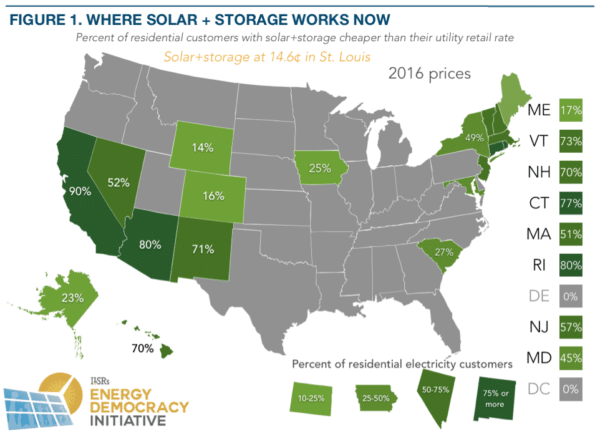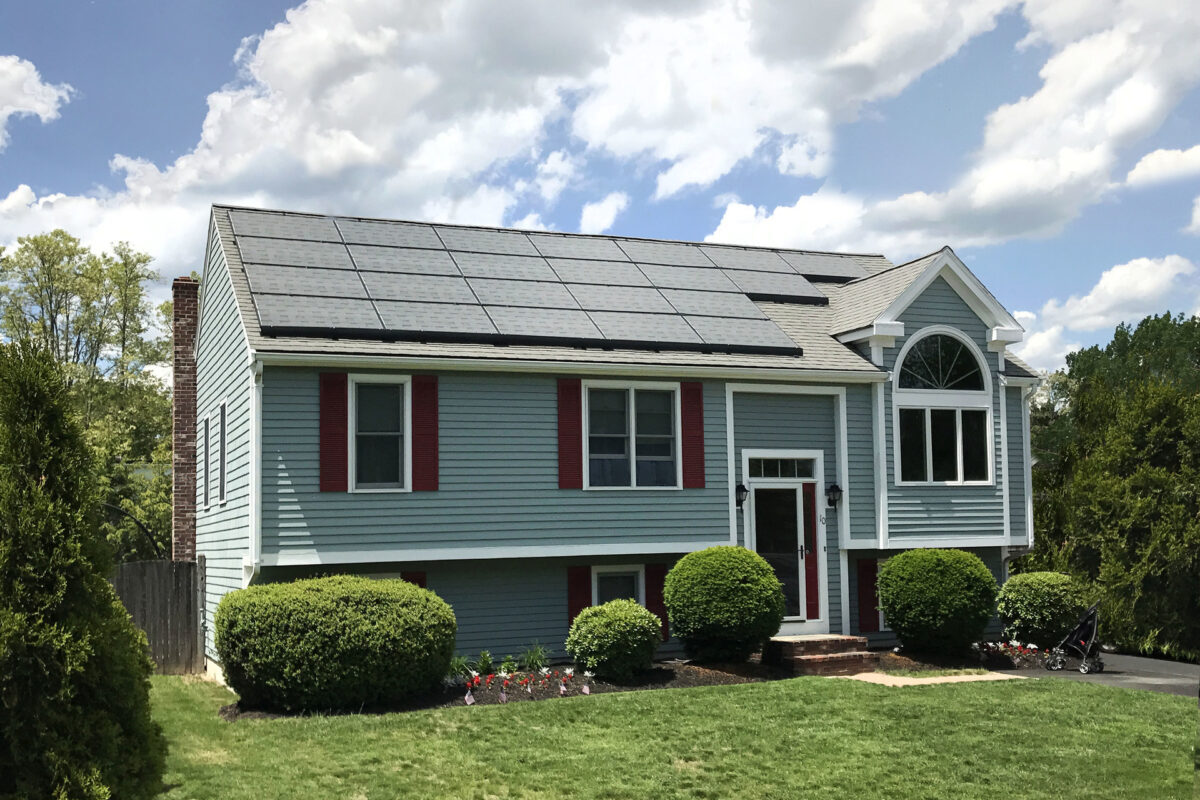by John Farrell, Institute for Local Self-Reliance
 Electric utilities rely on long planning horizons. Traditionally, they favored building large power plants and high voltage transmission lines, paid off over a generation. Many still do. Federal agencies report that power plant owners plan to build over 60 gigawatts of new gas power plant capacity over the next four years alone.
Electric utilities rely on long planning horizons. Traditionally, they favored building large power plants and high voltage transmission lines, paid off over a generation. Many still do. Federal agencies report that power plant owners plan to build over 60 gigawatts of new gas power plant capacity over the next four years alone.
But while utilities and regulators plan to spend tens of billions of dollars on large power plants, millions of customers are building their own generating capacity. The following ten-year time-lapse of California’s distributed solar installations shows more than a few thousand solar arrays. It also suggests a major reversal of energy sector decision-making power.
(Editor’s note: animation can be viewed online here)

Over the past decade, 700,000 electricity customers made the individual decision to go solar. Collectively and with no central planning, these individual decisions have added more than 7 gigawatts of electricity generation capacity to the California grid––15 percent of the system peak load. No corporate boards were involved. No formal comments filed. No resource plans submitted. California has set the pace, but five other states already sport at least 300 megawatts of distributed solar.
Utilities have pushed back. In states with rapid growth, a tug-of-war is occurring between centralized and decentralized decision-making. Nevada customers lost, and then regained net metering. New York regulators have proposed a complex new formula to replace net metering that may be less favorable to customer generation. Hawaiian utilities have all but ended buybacks of surplus solar power from their customers.
But a new disruptive, distributed technology––battery storage––threatens to tip the scales in favor of distributed decision making.
According to a new report from the Institute for Local Self-Reliance (ILSR), the combination of on-site solar and energy storage at today’s prices already competes with the price of utility service for 26 million residential electricity customers in 19 states. Clean Energy Group reports one in four commercial electricity customers could save money by cutting utility demand charges with battery storage.

Solar customers are quickly taking advantage of this new competitive opportunity. In 2018, one in five Sunrun residential solar customers added storage alongside their solar arrays. And battery prices are continuing to drop, rapidly.
For customers, on-site storage weakens their utility’s pricing power, allowing them to avoid demand charges or adjust easily to time-of-use rates. It also weakens the utility’s political power, because solar customers (like those in Nevada) become solar voters, prepared to intervene in energy policy debates.
For utilities, the coming collision of centralized planning and decentralized competition could result in what Charleston Post and Courier reporter Tony Bartelme calls a “bonfire of risky spending.” Any new fossil fuel power plant––such as the 60 gigawatts of gas in the pipeline––could end up being a stranded asset. If utilities raise their retail prices to compensate for losses, more customers are likely to save money by powering their own homes (and cars).
Already, cost-effective competition from solar and, increasingly, storage has stalled a proposed California gas power plant. In Arizona, the potential of storage caused regulators this year to halt the construction of any new, large gas power plants. For good reason. If half of California’s existing residential and commercial solar customers added batteries to their solar arrays, for example, the collective capacity could lower the entire evening peak by nearly 1.2 gigawatts––almost 6 percent!
Customer-sited distributed clean energy has an edge over centralized resources because it not only saves an individual money, but it also offers value to the whole system. It avoids transmission and distribution charges. It can be deployed far more rapidly than utility-scale systems. It does not rely on a lengthy regulatory approval process. It can be financed at lower rates than the utility cost of capital. And, distributed solar-plus-storage provides more jobs and greater local economic benefits, according to ILSR’s new report.
Many utilities fight these facts. Many have convinced regulators, who have approved tariffs that discourage on-site generation. But with storage, the individual bargaining power of the growing number of consumer/producers increases, just as their political power has with the spread of distributed solar.
California and Hawaii have been contending with these issues for a decade, where policy and high electricity costs made decentralized power competitive before its time. Other states won’t have the luxury to wait, as cost savings from mass producing distributed solar and storage rapidly reach parity with grid prices across the country. By 2022, ILSR estimates that nearly half of all residential electricity customers, in all but four states, could tap solar plus storage as a competitive alternative to grid electricity.
Utilities and public regulators must act now to recognize the role reversal of distributed and centralized energy resources. Rules must be changed to properly value customer-sited energy sources. System planning must include accurate forecasts for distributed energy growth. The approval process for large-scale fossil fuel investments must weigh the rising risk that such investments will become stranded.
The four recommendations that follow — that correspond to four key levels of oversight — provide essential ways to prepare for this imminent reverse power flow:
- Utility regulators should defer approval of any new fossil fuel power plant until a full, independent evaluation of alternatives is completed. Evaluations must consider distributed energy solutions, as well as increased energy efficiency and demand response.
- Regional market operators should enhance markets for ancillary services to value capacity and speed, lower participation thresholds to at least 100 kilowatts, and enable aggregation.
- State regulators should join 12 states (graded “A”) in adopting modern and streamlined interconnection rules for distributed energy resources.
- City officials should simplify permitting for distributed energy resources to avoid, for example, New York City’s effective murder of a virtual power plant project due to restrictive permitting for battery installation.
For one hundred years, most, if not all, meaningful electricity system decisions passed through utility boardrooms or regulatory hearing rooms. California’s growing number of solar owners––and the rise of competitive storage––suggest that era is over.
John Farrell directs the Energy Democracy Initiative at the Institute for Local Self-Reliance and widely known as the guru of distributed energy. He is best known for his vivid illustrations of the economic and environmental benefits of local ownership of decentralized renewable energy.
This content is protected by copyright and may not be reused. If you want to cooperate with us and would like to reuse some of our content, please contact: editors@pv-magazine.com.








Do you have any info on reverse powerfollow systems and you meantioned battery falling in price do you have more info on this and what is happening with battery backup for homes and businesses? What is Tesla and others doing with their home and business battery backups?
Thanks Michael Culotta mmcul@hotmail.ca
Expected better from John Farrell.
Why use the term “Power Flow” when it has an older and better-defined meaning in the power industry.
Also, regarding this statement.
” It can be financed at lower rates than the utility cost of capital.”
Utilities have had and will for the near future have a much lower Cost of Capital. If you look at the NYU Stern’s analysis, it shows that Utilities have a CoC of 3.28%, Power at 4.0%, and Green at 5.77%. This is just the Cost of Capital, the debt rates are higher than these numbers for residential solar as it is expensive to do buinsess for small value loans.